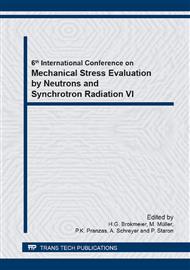[1]
Davis JR. Stainless steels. Ohio: ASM international, (1999).
Google Scholar
[2]
Herlach D. Hydrogen embrittlement of metals. Physica B: Condensed Matter 2000; 289-290(1-2): 443-446.
DOI: 10.1016/s0921-4526(00)00431-2
Google Scholar
[3]
Lewis F a. Solubility of hydrogen in metals. ChemInform 1991; 22(8): 353-353.
Google Scholar
[4]
Toribio J. Role of crack-tip residual stresses in stress corrosion behaviour of prestressing steel. Construction and Building Materials 1998; 12(5): 283-287.
DOI: 10.1016/s0950-0618(98)00010-5
Google Scholar
[5]
Vanboven G, Chen W, Rogge R. The role of residual stress in neutral ph stress corrosion cracking of pipeline steels. part i: pitting and cracking occurrence. Acta Materialia 2007; 55(1): 29-42.
DOI: 10.1016/j.actamat.2006.08.037
Google Scholar
[6]
Chen W, Vanboven G, Rogge R. The role of residual stress in neutral ph stress corrosion cracking of pipeline steels – part ii: crack dormancy. Acta Materialia 2007; 55(1): 43-53.
DOI: 10.1016/j.actamat.2006.07.021
Google Scholar
[7]
Ghosh S, Rana VPS, Kain V, Mittal V, Baveja SK. Role of residual stresses induced by industrial fabrication on stress corrosion cracking susceptibility of austenitic stainless steel. Materials & Design (2011).
DOI: 10.1016/j.matdes.2011.03.012
Google Scholar
[8]
Genzel C, Denks I, Gibmeier J, Klaus M, Wagener G. The materials science synchrotron beamline eddi for energy-dispersive diffraction analysis. Nuclear Instruments and Methods in Physics Research Section A: Accelerators, Spectrometers, Detectors and Associated Equipment 2007; 578(1): 23-33.
DOI: 10.1016/j.nima.2007.05.209
Google Scholar
[9]
Kannengiesser T, Kromm A, Rethmeier M, Gibmeier J, Genzel C. Residual stresses and in-situ measurement of phase transformation in low transformation temperature (ltt) welding materials. International Centre for Diffraction Data 2009; 23(2): 755-762.
DOI: 10.1154/1.2951824
Google Scholar
[10]
Martinezperez M, Mompean F, Ruizhervias J, Borlado C, Atienza J, Garciahernandez M, Elices M, Gilsevillano J, Peng R, Buslaps T. Residual stress profiling in the ferrite and cementite phases of cold-drawn steel rods by synchrotron x-ray and neutron diffraction. Acta Materialia 2004; 52(18): 5303-5313.
DOI: 10.1016/j.actamat.2004.07.036
Google Scholar
[11]
Gnaeupelherold T, Prask H, Fields R, Foecke T, Xia Z, Lienert U. A synchrotron study of residual stresses in a al6022 deep drawn cup. Materials Science and Engineering A 2004; 366(1): 104-113.
DOI: 10.1016/j.msea.2003.08.059
Google Scholar
[12]
Singh DRP, Deng X, Chawla N, Bai J, Hubbard C, Tang G, Shen Y-L. Residual stress characterization of al/sic nanoscale multilayers using x-ray synchrotron radiation. Thin Solid Films 2010; 519(2): 759-765.
DOI: 10.1016/j.tsf.2010.08.148
Google Scholar
[13]
Boellinghaus T. Hydrogen assisted cracking of supermartensitic stainless steels. In: Moody NR, Thompson AW, Ricker RE, Was GW, Jones RH, editors. Tms, Usa: Hydrogen Effects On Materials Behavior And Corrosion Deformation Interactions, TMS, USA, 2004. pp.1009-1018.
Google Scholar
[14]
Boellinghaus T, Hoffmeister H. Hydrogen permeation in supermartensitic stainless steels. In: Conf. corrosion. 2000. p.00141.
Google Scholar
[15]
Dabah E, Kannengiesser T, Eliezer D, Boellinghaus T. In situ analysis of hydrogen behaviour in stainless steels by high energy synchrotron radiation. Materials Science and Engineering: A (2010).
DOI: 10.1016/j.msea.2010.10.090
Google Scholar
[16]
Robertson IM, Birnbaum HK. Dislocation mobility and hydrogen. Materials Research n. d.
Google Scholar
[17]
Robertson IM. The effect of hydrogen on dislocation dynamics. Engineering Fracture Mechanics 2001; 68(6): 671–692.
DOI: 10.1016/s0013-7944(01)00011-x
Google Scholar


